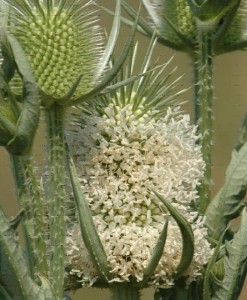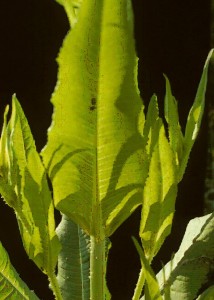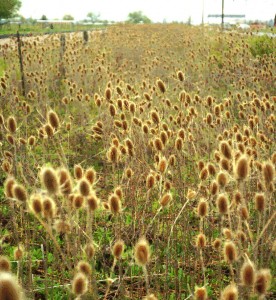Teasel
Dipsacus fullonum & D. laciniatus
Common (Fuller’s) & Cut-leaved Teasel
Native Origin: Both species are native to Europe, North Africa and Asia. European settlers probably introduced common teasel early in the 18th century. “Fulling” cloth meant the process of cleaning, pulling, weighting, and compressing fibers into felt and other textiles; dried flower heads, attached to spindles, were used to raise nap on cloth.
Description: Mature teasel plants die after flowering and seed set. Seedlings form a basal rosette of leaves that grows at least one year, often for several seasons, as the long taproot up to two feet deep develops. When the plant has accumulated enough energy stores, the long stalk, tipped with distinctive flower heads, appears.
The oval to oblong leaves of the rosette can spread 2 feet or more. Flowering stalks can reach 6 to 7 feet; stem leaves are opposite and joined around the stem, forming cup-like reservoirs. Leaves of common teasel are long and toothed with prickles on the margins; cut-leaf teasel leaves are lobed and hairy on the margins. The small, individual flowers are densely packed along the oval heads, which bear long up-turned bracts at the base. Common teasel has purple to pinkish-white flowers; cut-leaved teasel flowers are white. Blooming time ranges from June through October.
The rapid spread of teasel during the last 30 years may be due to the expansion of highway systems as mowing equipment readily carries seeds. Teasel also is grown as an ornamental and is a popular addition to dried-flower arrangements, a use that has aided seed distribution particularly around cemeteries.
Habitat & Ecological Effect: Teasel grows in open sunny areas in wet to dry conditions. One plant can produce more than 2,000 seeds; seed remains viable for at least two years and germination rates up to 80% can occur. Immature seed heads can continue to produce viable seed.While both species can invade natural areas, cut-leaved teasel is more aggressive and can quickly take over an area, creating a single species monoculture. Teasel out-competes and replaces native vegetation, and degrades native plant prairies, glades and meadows, and open woodlands.
Control: Individual plants can be dug and removed, taking care to get as much of the root as possible to reduce or prevent resprouting. Flowering stalks can be cut and removed but should not be cut until flowering has begun, since the plants retain enough energy reserves to send up new stalks. Flowering heads should be removed from the area and destroyed, since even immature flowers can produce seed.
Chemical: Foliar application of systemic herbicide such as glyphosate (Roundup) can be used in areas of extensive teasel growth and can be applied to plants in the rosette stage during the fall, when most native plants have entered dormancy but teasel remains active. Repeat monitoring and control measures generally will have to be done.
Comments are currently closed.



